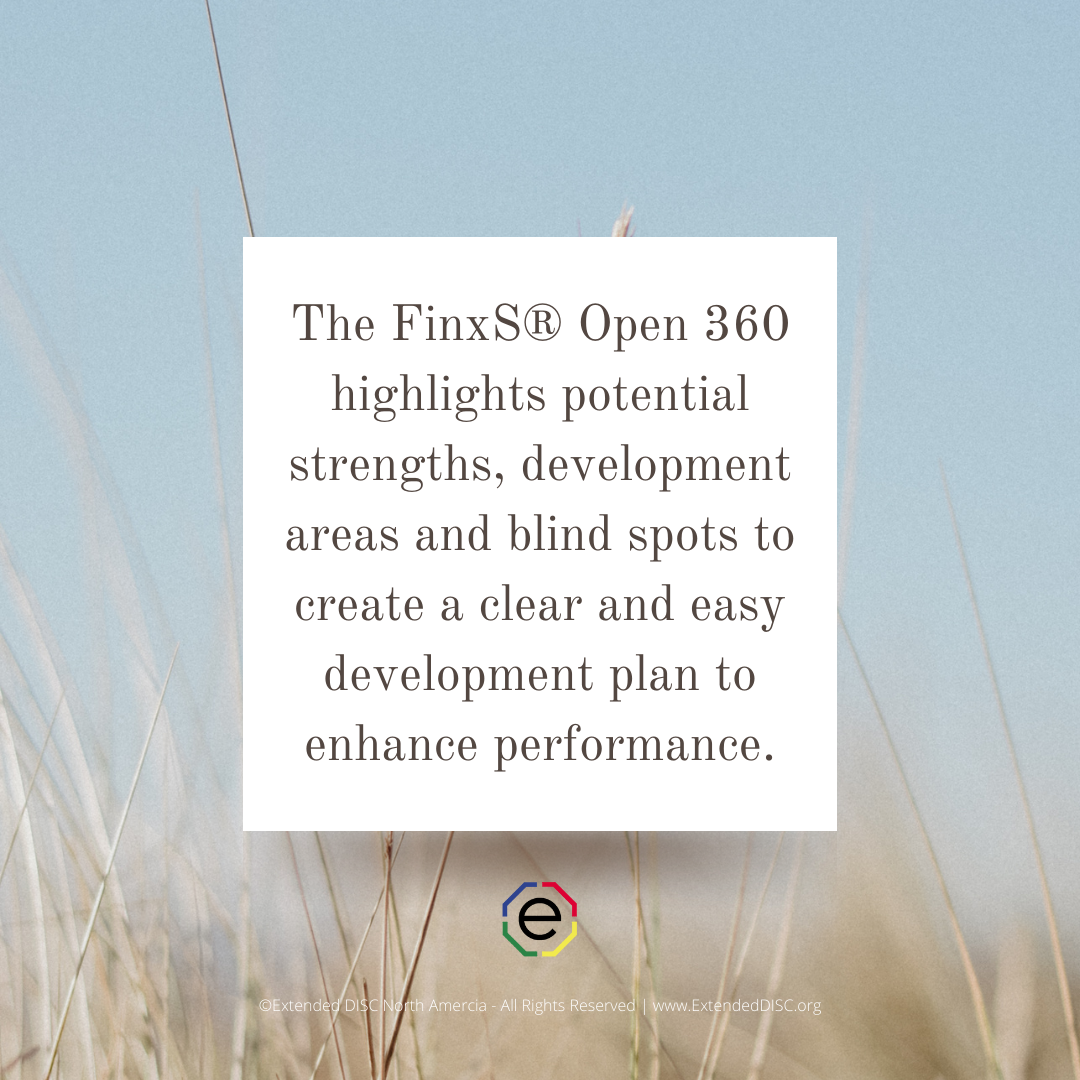Welcome to the world of 360s. The FinxS® Open 360 multi-rater report is a great tool to have in your coaching tool box and partners well with individual Extended DISC® reports.
 An Extended DISC® report reflects feedback the participant gives themselves. The FinxS® Open 360 is a multi-rater report where the subject receives candid feedback from assigned stakeholders, including themselves. Marrying up both reports is a powerful step and allows you to co-create a road map to work on self-awareness and career development areas.
An Extended DISC® report reflects feedback the participant gives themselves. The FinxS® Open 360 is a multi-rater report where the subject receives candid feedback from assigned stakeholders, including themselves. Marrying up both reports is a powerful step and allows you to co-create a road map to work on self-awareness and career development areas.
What is a FinxS® Open 360?
A FinxS® Open 360 is a tool that solicits feedback from a wide array of stakeholders such as managers, direct reports, colleagues, customers and self. It is designed to provide actionable feedback to the participant. This review does not replace a performance review written from the lens of the manager. It is not a document to use for promotions, disciplinary action, salary increases, etc. Done well, a 360 can really boost an employee’s potential by identifying areas they thrive and areas that they need to work on.
Getting started
The FinxS® Open 360 does have a learning curve, but you will quickly become comfortable if you follow the instructions. It is unlikely that you will be perfect out of the gate as there are many moving parts to a 360 program. Give yourself some grace and seek feedback as you go along so you can practice continuous improvement and hone your 360 skills.
For the process to work, the 360-review must connect with the overall strategic aims of the organization. Initial discussion needs to cover:
- What are you looking to achieve?
- How will you meet those objectives?
- What competencies are you evaluating?
- Who will receive a copy of the report?
- How will the feedback be delivered?
- What is the timeline? Who are the participants?
If it is developmental in nature, only the person debriefing and the person being evaluated see the results. In this situation it is left up to the employee to decide what information they share. The best results are generated when the process is focused on personal and professional development. Personal development specifically increases self-awareness. Professional development focuses on critical areas that are in need of attention. Non-technical areas, like leadership skills or improved teamwork are more challenging to change. Oftentimes, it is easier to work on technical skills.
Confidentiality
 Confidentiality throughout the 360-review must be guaranteed or you will undermine both the feedback and the process. Without anonymity raters may not feel comfortable answering the questions honestly and the receiver may question the accuracy of the results. Direct reports have a tendency to rate their manager higher while peers, depending on the relationship, may rate slightly lower – especially if their relationship is competitive.
Confidentiality throughout the 360-review must be guaranteed or you will undermine both the feedback and the process. Without anonymity raters may not feel comfortable answering the questions honestly and the receiver may question the accuracy of the results. Direct reports have a tendency to rate their manager higher while peers, depending on the relationship, may rate slightly lower – especially if their relationship is competitive.
A guarantee of anonymity makes it a safe place for both the rater and the participant. A rater will provide more useful feedback when they know they cannot be identified.
Depending on the circumstances, the 360-review process will need someone to manage it, for instance the HR partner, manager or an external coach or consultant.
An external coach/consultant may be helpful as employees will be more comfortable speaking with someone outside the company rather than their internal partner.
Does it replace a performance review?
No. A performance review is written from the lens of the manager. The FinxS® Open 360 has a broader scope and as the name suggests seeks data from a number of sources.
Determining the questions
There are multiple types of questions that can be included depending on the purpose of the assessment. Two types are Scale Questions or Open-ended Questions:
- Scale Questions: The question rates the employee on a scale such as 1-5, N/O (Not Observed). You can pick your scale and the identifier that pairs with the rating.
- Open Ended Questions: Gives opportunity to discuss in more detail about observable behavior. This is often where the best information comes from.
Don’t make your assessment too complicated. Identify the areas that you want to focus on and choose/create the questions.
The Process
Schedule the initial meeting with the stakeholders to discuss the objectives, format, competencies, timeline, approval process and the nature of feedback. This is where you will determine what is expected and design the program.
Kick-off Meeting
 After the approved process is complete, schedule a kick off meeting with the participants to explain the program and answer questions. This is a critical time to set the tone and emphasize the process is confidential. Explain how feedback works and what they can expect.
After the approved process is complete, schedule a kick off meeting with the participants to explain the program and answer questions. This is a critical time to set the tone and emphasize the process is confidential. Explain how feedback works and what they can expect.
Write up answers to commonly asked questions that would be useful to all participants. Post it on an accessible channel or email it to the group immediately following the kick-off meeting.
Choosing the Raters
It is important to get the right raters. The raters must have a working knowledge of the participants. They must/may include:
- Self (Mandatory)
- Manager (Mandatory)
- Direct Reports
- Colleagues/peers
- Customers
Talk to your group about who that is and suggest how to approach them. The participants can decide to contact the rater either in person, telephone or email. The key idea is the rater needs to be aware that the questionnaire is coming and that their candid input is encouraged. You will pre-identify a minimum and a maximum number of raters required. Approximate guideline is a minimum of 6-8 and a maximum of 12-14.
Now you're ready
A 360 is a great way to help your participant discover things about themselves they may have otherwise not figured out. Expect to be surprised, it is a powerful tool that can make a difference in their career. Preparation is the key to success. There is not a one size fits all. Each 360 is unique.
Good luck – you got this!

